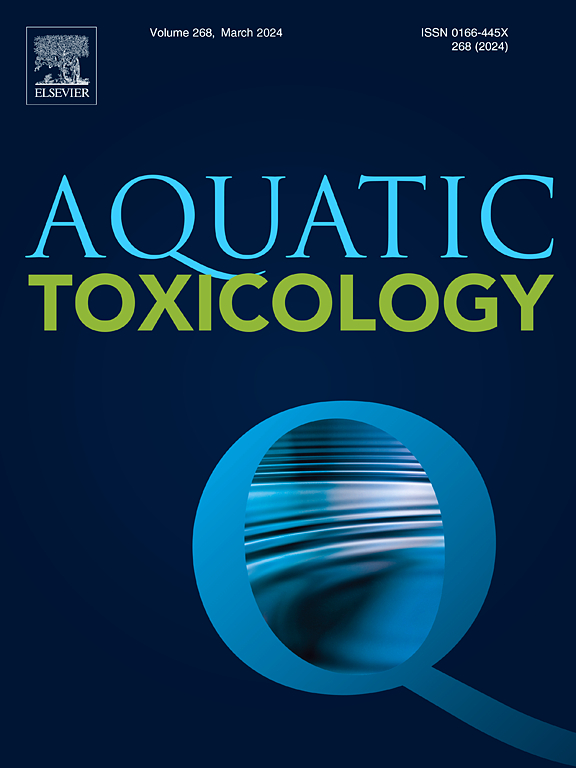Detrimental effects of glyphosate on muscle metabolism in grass carp (Ctenopharyngodon idellus)
IF 4.3
2区 环境科学与生态学
Q1 MARINE & FRESHWATER BIOLOGY
引用次数: 0
Abstract
Glyphosate, a commonly used herbicide, has been associated with environmental pollution and potential health risks to aquatic organisms. This study investigated the effects of glyphosate on the muscle metabolism of grass carp (Ctenopharyngodon idellus) following exposure to environmentally relevant concentrations. Over a 14-day exposure period to varying glyphosate levels, significant disruptions were observed in antioxidant capacity and muscle health. These disruptions were evidenced by reductions in total antioxidant capacity (T-AOC), increases in malondialdehyde (MDA) levels, and decreases in activities of glutathione peroxidase (GSH-PX) and catalase (CAT). Furthermore, exposure to glyphosate resulted in a reduction of vitamin E content and an elevation of hormonal levels, suggesting the potential for endocrine disruption. Metabolomics analysis identified 605 distinct metabolites, with notable alterations in amino acid, carbohydrate, and nucleotide metabolism pathways. Specifically, arginine and glutathione metabolisms were severely impacted, with decreases in key amino acids such as glycine and glutathione at higher glyphosate concentrations. Nucleotide metabolism, particularly purine synthesis, was also significantly affected, with reduced levels of deoxyguanosine and other purine-related compounds. The study further investigated the origins of these differential metabolites using the MetOrigin platform, suggesting a potential involvement of the intestinal microbiota in the metabolic response to glyphosate. These findings highlight the multifaceted adverse effects of glyphosate on fish muscle, including oxidative stress and metabolic dysregulation, which may contribute to diminished muscle quality and health risks for aquatic organisms.
草甘膦对草鱼(Ctenopharyngodon idellus)肌肉代谢的有害影响。
草甘膦是一种常用的除草剂,与环境污染和对水生生物的潜在健康风险有关。本研究调查了草甘膦暴露于环境相关浓度后对草鱼(Ctenopharyngodon idellus)肌肉代谢的影响。在不同草甘膦浓度的 14 天暴露期内,观察到抗氧化能力和肌肉健康受到了显著干扰。这些干扰表现为总抗氧化能力(T-AOC)降低、丙二醛(MDA)水平升高以及谷胱甘肽过氧化物酶(GSH-PX)和过氧化氢酶(CAT)活性降低。此外,接触草甘膦会导致维生素 E 含量减少和激素水平升高,这表明草甘膦可能会扰乱内分泌。代谢组学分析确定了 605 种不同的代谢物,其中氨基酸、碳水化合物和核苷酸代谢途径发生了显著变化。具体来说,精氨酸和谷胱甘肽的代谢受到严重影响,草甘膦浓度越高,甘氨酸和谷胱甘肽等关键氨基酸的含量越低。核苷酸代谢,尤其是嘌呤合成,也受到严重影响,脱氧鸟苷和其他嘌呤相关化合物的含量减少。研究利用 MetOrigin 平台进一步调查了这些不同代谢物的来源,表明肠道微生物群可能参与了草甘膦代谢反应。这些发现凸显了草甘膦对鱼类肌肉的多方面不利影响,包括氧化应激和代谢失调,这可能会导致肌肉质量下降,并对水生生物的健康造成危害。
本文章由计算机程序翻译,如有差异,请以英文原文为准。
求助全文
约1分钟内获得全文
求助全文
来源期刊

Aquatic Toxicology
环境科学-毒理学
CiteScore
7.10
自引率
4.40%
发文量
250
审稿时长
56 days
期刊介绍:
Aquatic Toxicology publishes significant contributions that increase the understanding of the impact of harmful substances (including natural and synthetic chemicals) on aquatic organisms and ecosystems.
Aquatic Toxicology considers both laboratory and field studies with a focus on marine/ freshwater environments. We strive to attract high quality original scientific papers, critical reviews and expert opinion papers in the following areas: Effects of harmful substances on molecular, cellular, sub-organismal, organismal, population, community, and ecosystem level; Toxic Mechanisms; Genetic disturbances, transgenerational effects, behavioral and adaptive responses; Impacts of harmful substances on structure, function of and services provided by aquatic ecosystems; Mixture toxicity assessment; Statistical approaches to predict exposure to and hazards of contaminants
The journal also considers manuscripts in other areas, such as the development of innovative concepts, approaches, and methodologies, which promote the wider application of toxicological datasets to the protection of aquatic environments and inform ecological risk assessments and decision making by relevant authorities.
 求助内容:
求助内容: 应助结果提醒方式:
应助结果提醒方式:


